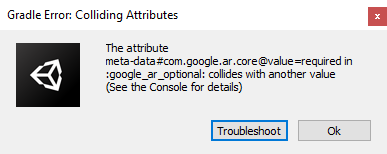This tutorial explains how to set up VisionLib object tracking when using AR Foundation in a Unity scene. You should already be familiar with setting up VisionLib in a Unity scene without AR Foundation, as described in the UnitySDK Quick Start.
Note: The ARFoundation support requires a license file containing the AllowInjectingImage feature.
AR Foundation is currently only supported on Android and iOS. Our implementation has been tested on Android 10, Android 11 and Android 12, as well as on iOS 13, iOS 14 and iOS 15.
VisionLib.SDK-Unity-X.Y.Z.tgz and Extensions/VisionLib.SDK.ARFoundation-Unity-X.Y.Z.tgz from the current VisionLib.SDK.Unity release. For more details and considerations regarding VisionLib Packages, see Install VisionLib Packages in Unity.Extensions/VisionLib.SDK.ARFoundation.Examples-Unity.unitypackage.Assets/VisionLib ARFoundation Examples/Scenes/.Adding VL Tracking to an Existing AR Foundation Scene).StreamingAssets/VisionLib/.TrackingConfiguration component of the VLTracking GameObject in the scene.Scenes in Build in the build settings.Configuring a Project for Building to Your Target Platform.File > Build Settings select Android and click on Switch Platform if it is not already selected.Edit > Project Settings > Player > Other Settings make the following changes:Vulkan is not the only enabled Graphics API, as Vulkan is not supported by ARCore. You will encounter the build error shown below if you attempt to build with Vulkan as the first option. You can either delete Vulkan from the list of Graphics APIs, replace Vulkan with another option (usually OpenGLES3) at the top of this list or enable Auto Graphics API. All three approaches will work. The former two options will enforce the exclusive use of the first API in the list. For further reading on the graphics API settings, refer to Unity's documentation on this topic. Minimum API Level is set to "Android 7.0 'Nougat' (API Level 24)". Otherwise, you will encounter the following error: Scripting Backend to IL2CPP, since Unity will not build for 64 bit ARM architectures using Mono.ARM64 in Target Architectures.ARMv7 to save build time and storage space.Edit > Project Settings > XR Plug-in Management > Android Settings > Plug-in Providers.Edit > Project Settings > XR Plug-in Management > ARCore set Requirement and Depth to "Optional". You may have to close and reopen the player settings window for the ARCore entry to appear under XR Plug-in Management. If you do not set Requirement to optional, you will encounter this error when attempting to build: 
File > Build Settings select iOS and click on Switch Platform if it is not already selected.Edit > Project Settings > Player > Other Settings set the Camera Usage Description to an arbitrary string, e.g. Augmented Reality. Use the purpose you want your user to see when they are asked to grant camera permission.ARKit XR Plugin by checking the ARKit toggle in XR Plug-in Management > iOS Settings > Plug-in Providers.To enable VisionLib object tracking in an existing AR Foundation scene, select Game Object > VisionLib > Add XR Tracking. This will add all necessary GameObjects and Components under a parent object called VLTracking to your scene. It will also try to connect them automatically to the AR Foundation GameObjects.
Once the VLTracking GameObject is created, set your tracking configuration in the public parameter of the object's Tracking Configuration component.
Adjust the Transform of the AR Camera, so that the camera is pointing to the tracking target from the point that should be used to start tracking.
Finally, add a TrackingAnchor component that connects Unity with VisionLib.
In the AR Foundation Example, we use the tracking configuration in StreamingAssets/VisionLib/Examples/ARFoundation/ModelTracking/InjectingModelTrackingConfiguration.vl. You can use this as a starting point for your own configuration file according to UnitySDK Quick Start. Make a separate copy of the file instead of modifying the existing file. This prevents issues from arising upon updates to new versions of VisionLib.
Set the path to your new tracking configuration file in the Tracking Configuration component in your scene. You will find this under VLTracking > Tracking Configuration.
Since Unity sets the position of the AR Foundation camera in meters, your model also has to be scaled accordingly. Also, set the metric to "m" in your tracking configuration file.
The components that connect AR Foundation with VisionLib are placed on the GameObject called VLXRCamera.

To reduce the workload that is created by VisionLib object tracking, set the Max Tracking FPS to a lower value - or increase it to trigger object tracking more frequently.
Testing AR Foundation scenes in the editor is inherently not possible with Unity out of the box. You can use the third-party plugin AR Foundation Remote from the asset store for this purpose. The specifics of using AR Foundation Remote with VisionLib are covered in AR Foundation Remote Plugin Setup.